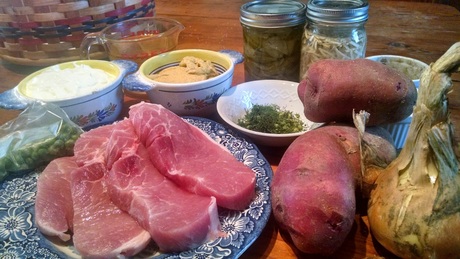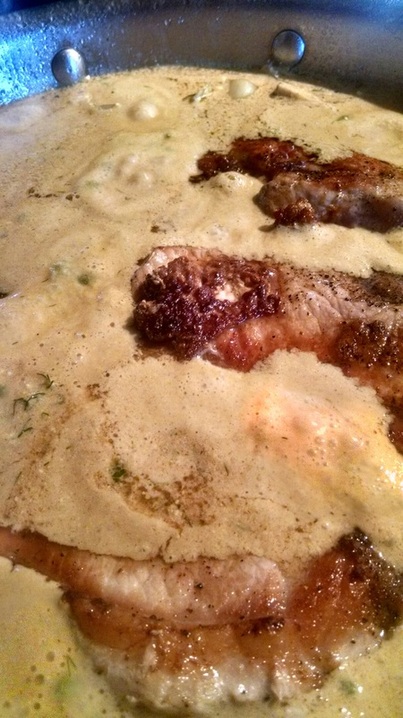Image may be NSFW.
Clik here to view.
Scrolling through the 87th pork casserole recipe, I realized that according to what I could find on the internet, if I didn't have canned cream of mushroom soup, bagged shredded yellow cheddar, or frozen tater tots, I wouldn't have a pork casserole. It was looking like the morning would end up being time for recipe development!
As a Culinary professional, I spend roughly 8 hours a day on my feet in a commercial kitchen. When I get home, I like to do nothing more than sit. So on the weekends, I like to create freezer-friendly family dinner meals to make the evening meal (and clean-up) easy for everyone. I try to avoid processed frozen dinners or convenience foods. Instead, I like to use as many of our own farm products- filling in with locally sourced items when necessary- to devise healthy, interesting and tasty weekly menus.
When I was in Culinary School, there was a class that wrapped-up it's final exam with what is called a "Mystery Box" or "Mystery Basket". Each student was expected to be able to take a container of unknown, seemingly unrelated items, and create a tasty, restaurant-quality meal from them. In my household, I seem to have a Mystery Basket challenge more often than not. We use what comes from our farm, from family member's gardens, or from local growers primarily. We must fill in with pantry staples from the commercial grocery store. This recipe reflects the spirit of the Mystery Box. Aside from the sour cream, mustard and pork, everything came from our farm. Our pigs are not quite ready to go to freezer camp, so I had to resort to store-bought pork- only because my husband bought it on sale weeks ago, and it needed to be used. This dish would also be wonderful using chicken, turkey, or a sturdy white fish or salmon.
Pork-tacular Potatoes
Clik here to view.
Many of these ingredients are classically Northern European. The Scandinavian cultures love dill, horseradish, and sour cream. But by all means, as with all of my blog recipes, use what you have, what you love, or what you can afford. As long as you include the free ingredients of love and passion, your dish will be delicious.
As always, I like to encourage my readers to establish their own gardens and vegetable patches, as well as patronize their local farms and growers. This however, takes time; time to plan and harvest a garden, as well as time to find local farmers and learn which producer specializes in what types of products. Most farmers - large or small- tend to favor certain vegetables, fruits or livestock based on their location, size, soil conditions and interest.
Because of government (over) regulation, artisan, organic, and grass-fed meats are more expensive than their factory-farmed cousins. Growers must butcher in a USDA inspected facility to sell to the public, which comes along with the accompanying fees- which of course they must pass along to their consumers. It is important for the buying public to understand that the difference in price reflects these government requirements, and not the farmer being "greedy". (Yes, I've actually heard of our hard-working American small farmers being called greedy- gah.)
Ok, getting off my soap-box now. Enjoy your food everyone! The possibilities are only contained by your imagination! Have fun and remember: No Farms No Food!
Clik here to view.

Scrolling through the 87th pork casserole recipe, I realized that according to what I could find on the internet, if I didn't have canned cream of mushroom soup, bagged shredded yellow cheddar, or frozen tater tots, I wouldn't have a pork casserole. It was looking like the morning would end up being time for recipe development!
As a Culinary professional, I spend roughly 8 hours a day on my feet in a commercial kitchen. When I get home, I like to do nothing more than sit. So on the weekends, I like to create freezer-friendly family dinner meals to make the evening meal (and clean-up) easy for everyone. I try to avoid processed frozen dinners or convenience foods. Instead, I like to use as many of our own farm products- filling in with locally sourced items when necessary- to devise healthy, interesting and tasty weekly menus.
When I was in Culinary School, there was a class that wrapped-up it's final exam with what is called a "Mystery Box" or "Mystery Basket". Each student was expected to be able to take a container of unknown, seemingly unrelated items, and create a tasty, restaurant-quality meal from them. In my household, I seem to have a Mystery Basket challenge more often than not. We use what comes from our farm, from family member's gardens, or from local growers primarily. We must fill in with pantry staples from the commercial grocery store. This recipe reflects the spirit of the Mystery Box. Aside from the sour cream, mustard and pork, everything came from our farm. Our pigs are not quite ready to go to freezer camp, so I had to resort to store-bought pork- only because my husband bought it on sale weeks ago, and it needed to be used. This dish would also be wonderful using chicken, turkey, or a sturdy white fish or salmon.
Pork-tacular Potatoes
2-3 pounds pork cutlets
1 1/2 cups sour cream (do not substitute low fat sour cream)
1 1/2 cups dijon-style mustard
1/2 cup horseradish
1 cup sliced garlic dill pickles (home canned or good quality)
1 large onion, chopped
1/4 cup chopped fresh dill
1 cup green peas
1 cup chicken stock (try to make your own)
Salt and pepper to taste
EVOO for saute
chives to garnish
5-6 large potatoes, boiled, and roughly smashed with butter, salt and pepper to taste. I like to keep the peels on my potatoes for smashing, but if you prefer to mash them more finely, remove the peel.
Place the cutlets into a gallon-sized zippered plastic bag. Give them a few whacks with a meat mallet to help tenderize the muscle fibers. Remove from the bag, and season with salt and pepper. In a large, heavy-bottomed skillet, drizzle approximately 1/4 cup of extra virgin olive oil.
(Try not to use vegetable, corn or canola oils as these products are very high in Omega-6 fats, which cause damaging inflammation in your body. Olive oils are the best to use for light to medium heat cooking. For deep frying, use peanut oil or lard.)
Brown the pork cutlets in the skillet and set aside. Add the onion and saute until golden. Add the chicken stock to deglaze. Stir in the sour cream, mustard, horseradish and dill. Add the peas and pickles and stir lightly to combine. Add back the pork and cook together with the sauce and allow to cook together for 10-15 minutes. Spray your storage pan with non-stick spray and pour the whole mixture into the pan. Allow to cool to room temperature, about 30 minutes. (Don't put hot casseroles into your freezer) Cover and store in your freezer. Remove the night before use to thaw in the refrigerator. Serve over smashed potatoes and garnish with chives.
Image may be NSFW.1 1/2 cups sour cream (do not substitute low fat sour cream)
1 1/2 cups dijon-style mustard
1/2 cup horseradish
1 cup sliced garlic dill pickles (home canned or good quality)
1 large onion, chopped
1/4 cup chopped fresh dill
1 cup green peas
1 cup chicken stock (try to make your own)
Salt and pepper to taste
EVOO for saute
chives to garnish
5-6 large potatoes, boiled, and roughly smashed with butter, salt and pepper to taste. I like to keep the peels on my potatoes for smashing, but if you prefer to mash them more finely, remove the peel.
Place the cutlets into a gallon-sized zippered plastic bag. Give them a few whacks with a meat mallet to help tenderize the muscle fibers. Remove from the bag, and season with salt and pepper. In a large, heavy-bottomed skillet, drizzle approximately 1/4 cup of extra virgin olive oil.
(Try not to use vegetable, corn or canola oils as these products are very high in Omega-6 fats, which cause damaging inflammation in your body. Olive oils are the best to use for light to medium heat cooking. For deep frying, use peanut oil or lard.)
Brown the pork cutlets in the skillet and set aside. Add the onion and saute until golden. Add the chicken stock to deglaze. Stir in the sour cream, mustard, horseradish and dill. Add the peas and pickles and stir lightly to combine. Add back the pork and cook together with the sauce and allow to cook together for 10-15 minutes. Spray your storage pan with non-stick spray and pour the whole mixture into the pan. Allow to cool to room temperature, about 30 minutes. (Don't put hot casseroles into your freezer) Cover and store in your freezer. Remove the night before use to thaw in the refrigerator. Serve over smashed potatoes and garnish with chives.
Clik here to view.

Many of these ingredients are classically Northern European. The Scandinavian cultures love dill, horseradish, and sour cream. But by all means, as with all of my blog recipes, use what you have, what you love, or what you can afford. As long as you include the free ingredients of love and passion, your dish will be delicious.
As always, I like to encourage my readers to establish their own gardens and vegetable patches, as well as patronize their local farms and growers. This however, takes time; time to plan and harvest a garden, as well as time to find local farmers and learn which producer specializes in what types of products. Most farmers - large or small- tend to favor certain vegetables, fruits or livestock based on their location, size, soil conditions and interest.
Because of government (over) regulation, artisan, organic, and grass-fed meats are more expensive than their factory-farmed cousins. Growers must butcher in a USDA inspected facility to sell to the public, which comes along with the accompanying fees- which of course they must pass along to their consumers. It is important for the buying public to understand that the difference in price reflects these government requirements, and not the farmer being "greedy". (Yes, I've actually heard of our hard-working American small farmers being called greedy- gah.)
Ok, getting off my soap-box now. Enjoy your food everyone! The possibilities are only contained by your imagination! Have fun and remember: No Farms No Food!